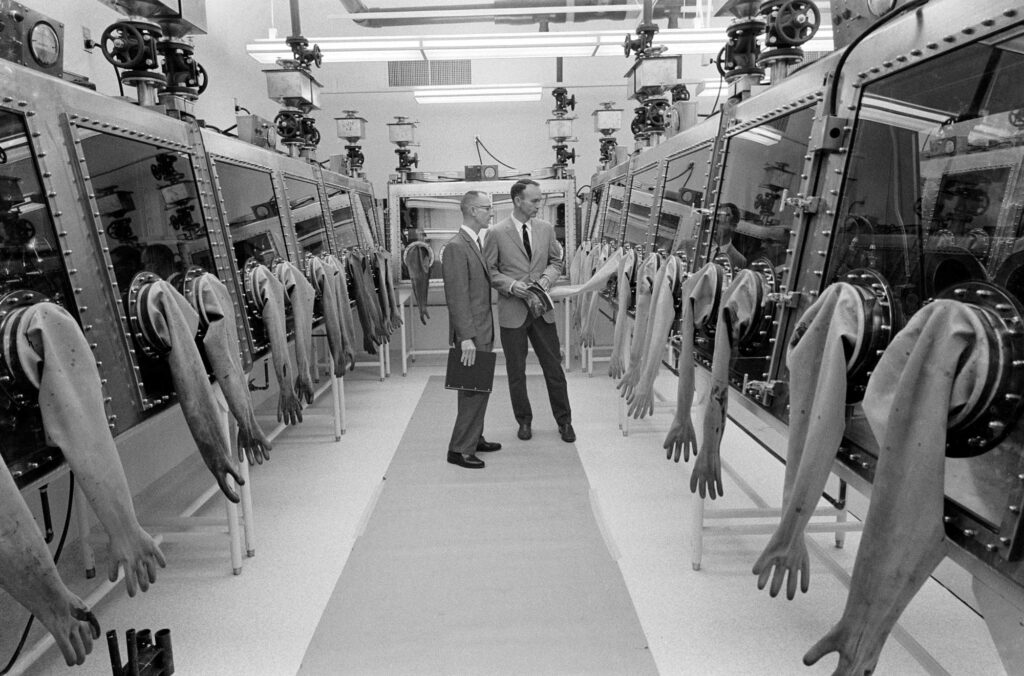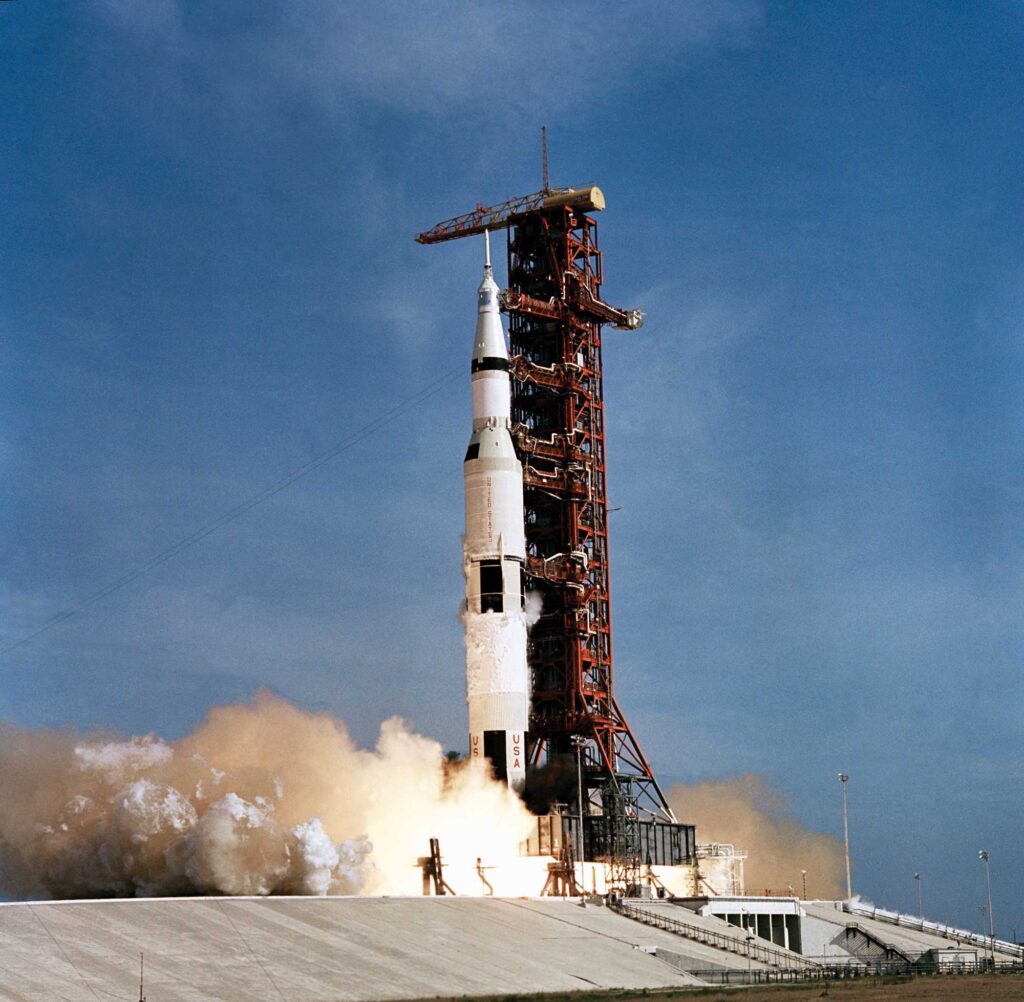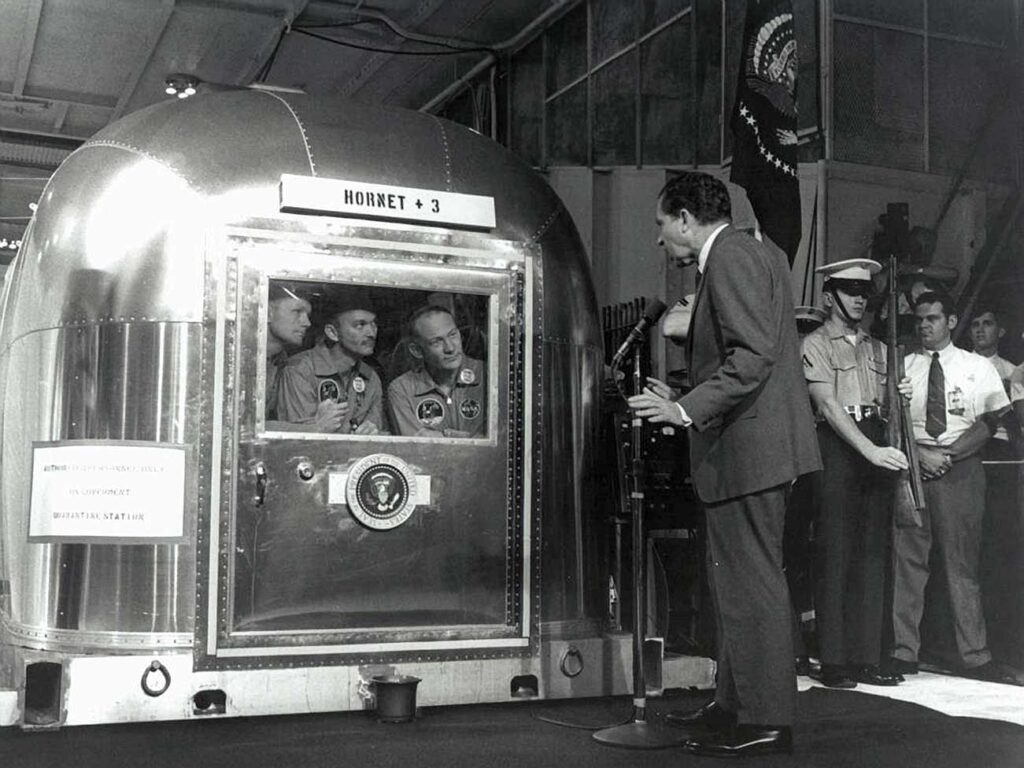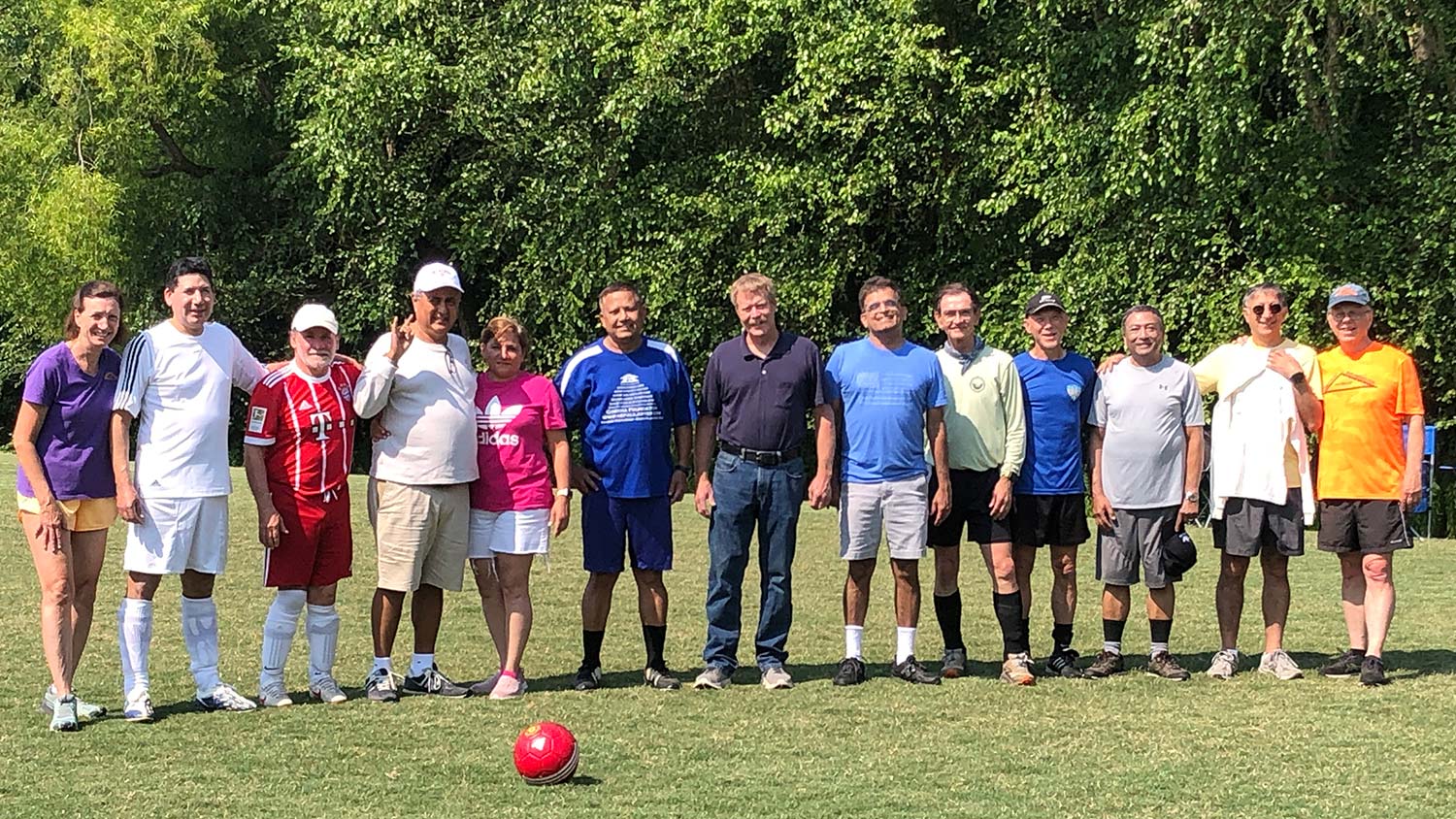In the summer of 1969, NASA had been around for 11 years. The decade since the United States space program had officially opened its doors in 1958 had passed quickly. Satellites had gone up. Monkeys had traversed the galaxy. Man had flirted with the stars. And the Soviet Union — which launched first satellite from Earth, Sputnik, into space in 1957 — had kicked off and accelerated a space race with America, one the U.S. was determined to win.
A decisive victory in that race came 50 years ago this summer. In July 1969, NASA landed the first man on the moon with the Apollo 11 mission. NASA engineers, scientists, pilots and astronauts worked around the clock in the lead-up to Eagle, the lunar module, touching down on the moon and the crew of Neil Armstrong, Michael Collins and Buzz Aldrin returning to Earth.
Key in that achievement were dozens of NC State alumni. Their jobs were varied. Some of the Wolfpack’s “moon men” had helped train astronauts. One sat in Mission Control, helping call the shots on the flight’s major decisions. Another tested trajectories astronauts could use in landing Eagle on the big bright rock. And one’s name appears on the Apollo 11 flight plan as one of its three authors. And those same men would go on to have long careers at NASA after Apollo 11, working on the Skylab and shuttle programs.
The July/August 1969 issue of NCSU Alumni News contained a list of 26 alumni who were working at NASA. Almost half of them have passed away. But the ones we caught up with had great stories to tell. Here are excerpts of our interviews presented as an oral history.
The Moon Men

| Clynton Ratliff ’51 | Lt. Col. (Ret.) George Colton ’58 | Don Tomlin ’59 | Jim Prim ’60 |
|---|---|---|---|
| Senior staff engineer at the Marshall Space Flight Center Huntsville, Alabama | Astronautical engineer at the Manned Spacecraft Center Houston, Texas | Aerospace engineer at the Marshall Space Flight Center | Crew integration engineer at the Manned Spacecraft Center |
| Ratliff helped work on developing the Saturn V. He retired from NASA in 1989 and died on May 7, 2017, while NC State magazine was reporting this story. He was 89. | Colton, 82, helped write Apollo 11’s flight plan. Retired from the U.S. Air Force in 1982. | Tomlin, 82, wrote some of the flight rules that spelled out for the flight controllers instructions for the stages of the Apollo missions. Retired from NASA in 1998. | Prim, 80, worked on projects involving the lunar module, including devising ways to help store items such as life-support systems. Retired from the Department of Energy in 1985. |

| Tom McPherson ’60 | Harold Draughon ’63 | Charles Arvey ’67 | ||
|---|---|---|---|---|
| Aerospace engineer at the Manned Spacecraft Center | Assistant flight director at the Manned Spacecraft Center | Aerospace engineer at the Manned Spacecraft Center | ||
| McPherson, 81, worked on the parachute system used in the Apollo missions. He was also a test director at the Lunar Receiving Laboratory, which held and analyzed samples collected from the moon. Retired from NASA in 2003. | Draughon, 82, was on the ground, helping the flight director make decisions crucial to the mission’s success. Retired from NASA in 1988. | Arvey, 74, studied lunar descent trajectories and analyses of landing profiles. Retired in 2014. |
The Work: “Original Science”
George Colton: When I got back from Vietnam, I got the orders [from the Air Force] that Johnson Space Center [known as the Manned Spacecraft Center] was where I was going. (Colton wrote flight plans at the Manned Spacecraft Center.)
Clynton Ratliff: I first worked on, a short time, the first stage of the Saturn V [the rocket that would eventually launch the Apollo 11 spacecraft into space]. (Ratliff helped develop rockets for a brief time at the Marshall Space Flight Center.)
Some of the engineers started at NASA before and during Project Mercury (1958–1963), which focused on orbiting a manned spacecraft around Earth. Some came along at the time of the Gemini program in the mid-1960s.
Jim Prim: We had a digital console sitting outside of the capsule. I could simulate launch. Teach the astronauts to correct from these problems. We had an analog computer that did all the launch trajectory and re-entry. . . . The rest of the time I spent with Gemini, Apollo. . . . I specialized in stowing stuff. My specialties were extra-vehicular activity, life-support systems and integration of experiments into the spacecraft. (Prim trained astronauts during the Mercury program.)

Harold Draughon: I came straight out of school and went to work at NASA. There was no time off. Just drove to Houston. . . . It was at the very start of the Gemini program. We were building up the network of tracking stations. That took me to the Canary Islands. We had two old Liberty ships from World War II. We would fly Super Constellation airplanes across the top of them, and we pretended that Super Connie airplane was the spacecraft. We would establish communication with it from the ship. We would send commands to it. (Draughon was based at the Manned Spacecraft Center in Houston and eventually became an assistant flight director by the time Apollo 11 came around.)
Don Tomlin: I never considered myself a top dog in kind of guiding things. But I did have some things where I did original science. One of them . . . when you put the vehicle on the launch pad, storms come up. And the wind comes up with them. They wanted to know the effects of wind. So I wrote a paper on ground winds. (Tomlin researched the effect of wind on launches at the Marshall Space Flight Center.)
Others joined NASA during the Apollo program, whose goal was to get American astronauts on the moon.
Tom McPherson: I went there in ’63 or ’64. By ’65 and ’66, Gemini was fading and Apollo was coming. So most of what I did was on the parachute system for the command module. The earth landing system. . . . It was building on work that had been done in the military during World War II. Cargo drops. Multiple parachute systems. High altitude systems. Apollo took that to the next level.
George Colton: When I came in, there was Apollo 8 [the December 1968 mission that was the first manned spacecraft to orbit the moon]. We were assigned to write the Apollo 8 flight plan. I started working on lunar maps.
As July 1969 approached and Apollo 11 was a go, the work the engineers had done for that mission was ready to pay off, starting with George Colton, one of three authors listed on the Apollo 11 flight plan.
George Colton: A flight plan is a timeline of who does what when. For any reason, that might change. Someone might leave out the activity, so you’d have to modify that activity so that it would fit the timeline.
Charles Arvey: One thing I did was run lunar descent trajectories. I did analysis of different profiles of going from the lunar orbiter going down to landing. I had a big printout. It was probably an inch, an inch-and-a-half thick. It was really close to the trajectory they ran.
Jim Prim: The lunar module was too heavy. The first thing that hit me was that we had two life-support systems that were mounted. We could take one of those off the wall. The system weighed about 150 pounds. Put it on the floor [of the module]. The floor is already stressed for the landing on the moon. . . . After I told them that, they did it.
Harold Draughon: I was an assistant flight director. It was one of the 14 or 15 positions in that room [Mission Control in the Manned Spacecraft Center in Houston]. You were committed to knowing your part. You did not want to be the person to make a mistake.

Tom McPherson: I worked through the development of the parachute system. I’d already moved on by the Apollo landing. I’d been asked to go to the Lunar Receiving Lab [also at the Manned Spacecraft Center]. I was waiting for lunar samples to come back. . . . It was a unique facility to handle the crew and samples that came back. It was a biological containment facility. My job was basically to keep that facility running.
The Life: “Chasing Buck Rogers”
Don Tomlin: When I got married, I think my in-laws were so proud of me being connected to that. You got a lot of merit if you were connected to NASA.
Tom McPherson: [Getting a job at NASA] was kind of like winning the lottery. It was one of those moments when everything becomes right.
Jim Prim: We were all trying to put the first man on the moon. Push science. Push. Push. . . . The space program was all-consuming. . . . We were constantly pushing the state of the art. That was addictive. There were a lot of divorces out of the space program.
Charles Arvey: We were in a race with the Soviet Union. We were convinced the Soviet Union was going to try to put a man on the moon. They had beaten us in so many things. The first satellite up. The first man in space. They had done so many things first. We needed something to be first.
Harold Draughon: There were a couple of entertainers who came to Houston to give concerts in the Astrodome just for the flight controllers. There were people who would have parties. It was a way to say “thank you.”
Clynton Ratliff: Buck Rogers was a comic book character. And I guess that intrigued me [as a child]. Seeing the little cartoons. And the verbiage concerning space travel. I think that influenced me as much as anything. . . . I had a cousin who said, “You’re following your dream. You’re chasing Buck Rogers.”
Harold Draughon: The thing that really overpowered you [was that] every day, the stuff we were doing, nobody had done before. You’d take a shot at it. You’d go into those simulations. You had to work really hard at visualizing a solution to a problem to something nobody had ever conceived of before.
One might imagine NASA’s space program of the 1960s as one cloaked in secrecy. But that wasn’t the case.
Charles Arvey: There wasn’t any secrecy about it, even though we had secret clearances at the time. Red badge was secret. Yellow was top secret. Blue was the lowest level of security.
Tom McPherson: Although I had secret clearance, I don’t remember a secret document. We had a file cabinet that was supposed to hold confidential documents.
George Colton: It was very open, particularly with what my background had been in the Air Force. When the real things happened, we had all kinds of dignitaries in.
The Astronauts: “Great To Deal With”
Charles Arvey: They were not only treated kind of special, but they were. They were top-notch pilots.
George Colton: The day-to-day was a fun job. . . . The crew members were always great to deal with.
Don Tomlin: Armstrong came down to [Huntsville, Ala.] to fly [the moon landing] simulation. And I was there with him when he was doing that flight. I had flown that simulation myself. I had trouble keeping it on course. Armstrong could talk and keep that thing on course without any difficulty. I found him to be very casual.

Jim Prim: Neil . . . came by my house and gave my daughter a doll, . . . an astronaut. He gave me three meerschaum pipes, and I started smoking again. We kept his youngest son while he made his around-the-world tour.
Blast Off: “That Rocket”
On the morning of July 16, 1969, at 9:32 a.m., the Apollo 11 mission launched from the Kennedy Space Center in Florida. The Saturn V rocket carried the command module Columbia, the lunar module Eagle and the crew — Collins, Armstrong and Aldrin — to its destiny.
Charles Arvey: The day before the launch, we jumped in my car. We drove over to the Cape [from Houston]. There were three or four checkpoints we went through. There were tens of thousands of people there. We watched the launch from as close as you could get to it. The VIPs, [Vice President Spiro] Agnew, were situated about 150 feet behind us. It was very few people that got that close to it. I still remember the rumbling of that rocket. It literally was like a thousand firecrackers going off. There was so much strength in those sound waves, and I never forgot that.

Four days after launch and after orbiting the moon, Armstrong and Aldrin flew Eagle and readied for a historic descent. Armstrong landed the vehicle a little after 4 p.m., with just under 30 seconds-worth of fuel left. Seven hours later. Armstrong logged history’s first moon walk.
Harold Draughon: It was just holding your breath and hoping nothing went wrong.
Charles Arvey: The alarm went off to abort. [Armstrong] was running out of fuel. But he knew he had one or two percent of fuel left. Armstrong was so close, he was either going to land on the moon or die on the moon. So he took over and landed it.
Jim Prim: When Neil got out the second time, I was in his living room watching it on television with his wife. My kids learned to swim in his swimming pool.
Charles Arvey: At the time, we were told we could go into the Mission Control viewing room and watch it. . . . But most of us stayed home to actually watch the landing. They had cameras when Aldrin stepped down off the ladder. You heard Armstrong say his famous words. That was quite a moment to know we were involved.
Don Tomlin: Incidentally, when we landed on the moon, I went up to my grandmother in Chickamauga, Ga. She said, “That’s a hoax.”
The flight controllers and the crew began to initiate re-entry on July 24, eight days after the historic mission began. Draughon, who was in Mission Control as an assistant flight director, says he remembers training for multiple scenarios and potential mishaps that might occur in that time frame. But luckily when the real thing happened, there were no problems, save for bad weather. The crew splashed down in the Pacific Ocean.
Tom McPherson: [The parachute system] was the last system that had to work. If that system didn’t work, I was going to be out of a job. [Laughs.]
Charles Arvey: I had several friends who worked in the landing and recovery division. One of my friends was the engineer who was put in that capsule with them when they were quarantined.
Jim Prim: When Neil was in the quarantine facility, there’s a picture of him playing a ukulele.

The Lunar Legacy: “The Puzzle”
Tom McPherson: You think about all the pieces of the puzzle that had to come together to make it happen. There was orbital dynamics. Flight mechanics. Communication. The infrastructure to put into place to get something like that done. People talk about going to Mars. They don’t realize what a monstrous task that is. They think it’s some casual thing. You don’t have to just build a rocket to get you there. You have to land. You have supplies. All the pieces of the puzzle have to be engineered. It was a step-by-step process that got you to the moon.

Harold Draughon: Putting in the sequence of what goes on what flights, that was the success. It was like planning the Normandy invasion.
Clynton Ratliff: Computers, cell phones, relay towers — it forced that into being.
George Colton: When I sit here in front of this computer, I have far more computer power at my fingertips than we had in the command center. The main computer was basically hard-wired.
Charles Arvey: It will always be a moment we can be proud of. It shows that this country can do things like that if they really put their minds to it. I think the Apollo era, especially Apollo 11, will be looked at as one of the great achievements of mankind.
Don Tomlin: The only thing I can say is, “Thank you, America, for letting me in on this.”
Editor’s Note: NC State began reporting this story in March 2017 in anticipation of the 50th anniversary of the Apollo 11 moon landing in 2019. Some of the quotes have been edited for length and clarity. In addition to phone interviews, we used alumni records and nasa.gov as sources.
- Categories:


